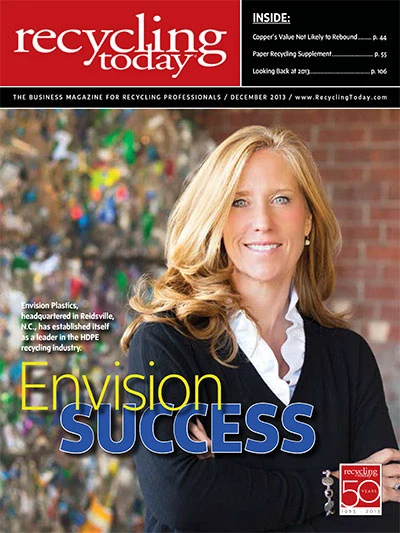 In late 2010, the National Wildlife Federation (NWF) was awarded a generous grant from the McGraw-Hill Cos. to develop and conduct a pilot textbook recycling and research project that would benefit McGraw-Hill’s sustainability commitment NewPage Corp.’s desire to increase recovered fiber in the U.S. as well as the NWF’s environmental education and sustainability programs, Eco- Schools USA and Campus Ecology.
In late 2010, the National Wildlife Federation (NWF) was awarded a generous grant from the McGraw-Hill Cos. to develop and conduct a pilot textbook recycling and research project that would benefit McGraw-Hill’s sustainability commitment NewPage Corp.’s desire to increase recovered fiber in the U.S. as well as the NWF’s environmental education and sustainability programs, Eco- Schools USA and Campus Ecology.
Goal
For the purposes of this project, we focused on the K-12 educational sector, the higher education sector and book publishers. The intent of our report is to highlight the life cycle of textbooks, from production through disposal, and to provide needed information and recommendations to interested sectors on how they might establish a textbook recycling program at their school, university or in their community.
Scope
What we found through our research was rather staggering. More than 4.3 billion books are produced annually in the U.S. for a variety of sectors. Unfortunately, many books—after they have reached the end of their useful lives—end up in landfills.
To address this, the NWF, McGraw-Hill and NewPage Corp. entered into a collaborative project to study textbook recycling in the U.S., pilot a recycling project and develop best practices to increase textbook recycling. This report, “A Research Study on Textbook Recycling in America: Recommendations for Proper Disposal and Repurposing at the End of a Textbook’s Useful Life,” available online at www.nwf.org/Eco-Schools-USA/Our-Partners/Textbook-Recycling-Program.aspx, is based on what currently happens to textbooks at the end of their useful lives. While the original assumption was that recycling books would be challenging, the research indicates that it requires discipline, structure, organization, an outlet and method for disposal and processing of books and a change in behavior when it comes to educating the public.
With more than 150,000 K-12 schools and 4,100 higher education institutions, the market for educational textbooks is significant. Our research showed that K-12 schools want to recycle textbooks but do not have enough information on how to institute a recycling program. And, for higher education institutions, many have paper recycling programs, but textbooks are not included in their mix. Most community recycling programs tend to focus on materials that are commonly recycled, such as copy paper, aluminum and steel cans, plastics and glass. Additionally, single-stream recycling is being adopted by an increasing number of American communities with mandates to increase diversion rates.
Education Best PracticesThe key step in the development of any recycling program is the education of all the potential participants. Educational institutions interested in establishing a book recycling program need to educate not only the students, faculty, book stores, libraries, community neighbors, building and facilities staff, but the team that is organizing these efforts [also] must be educated about setting achievable goals and implementing successful processes. Some suggested best practices to ensure that the staff, program team, students and interested parties are educated about the recycling process include:
– An edited excerpt from “A Research Study on Textbook Recycling in America: Recommendations for Proper Disposal and Repurposing at the End of a Textbook’s Useful Life” |
Results
By surveying K-12 schools, we found that more than 57 percent participate in book donation or “give away” programs and that 37 percent said they store obsolete textbooks because they are unsure what to do with them from a disposal standpoint. By surveying higher education institutions, we found more than 36 percent said they did recycle both hardbound and softbound textbooks, but 26 percent said they recycled neither.
Our team also spent a considerable amount of time researching the life cycle of textbooks. What we found is that there is significant fragmentation and diversity in the ways that educational institutions collect and process textbooks for recycling. To help alleviate that, we provided guidelines and best practices for educational institutions that we hoped would help them to facilitate the recovery of textbooks instead of landfilling them. These guidelines include education; establishment of a recycling mission, goals and objectives; communication; planning; facilitation; implementation; and evaluation.
After all, an unusable or unwanted book is a terrible thing to waste.
Implementation Best PracticesImplementing a book recycling program is where the “rubber hits the road.” This is where the efforts you’ve expended through the education, communication, planning and facilitation processes bear fruit. This is also where you need to have the best handle on program logistics and partner relationships. Suggested best practices for implementation include:
– An edited excerpt from “A Research Study on Textbook Recycling in America: Recommendations for Proper Disposal and Repurposing at the End of a Textbook’s Useful Life” |
The author is senior director of Eco-Schools USA, a program of the National Wildlife Federation. Email her at hickey@nwf.org.

Explore the December 2013 Issue
Check out more from this issue and find your next story to read.
Latest from Recycling Today
- Phoenix Technologies closes Ohio rPET facility
- EPA selects 2 governments in Pennsylvania to receive recycling, waste grants
- NWRA Florida Chapter announces 2025 Legislative Champion Awards
- Goldman Sachs Research: Copper prices to decline in 2026
- Tomra opens London RVM showroom
- Ball Corp. makes European investment
- Harbor Logistics adds business development executive
- Emerald Packaging replaces more than 1M pounds of virgin plastic





